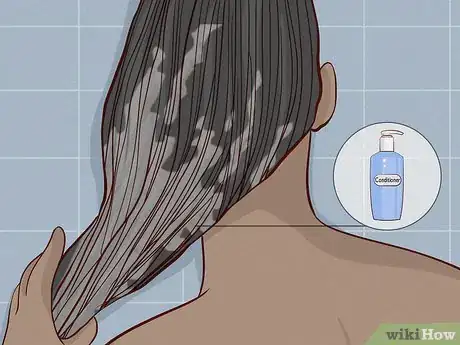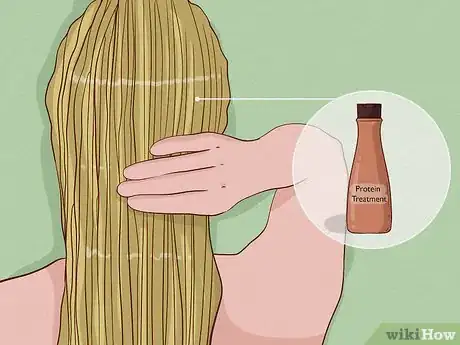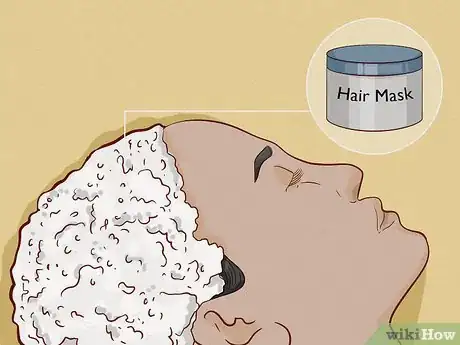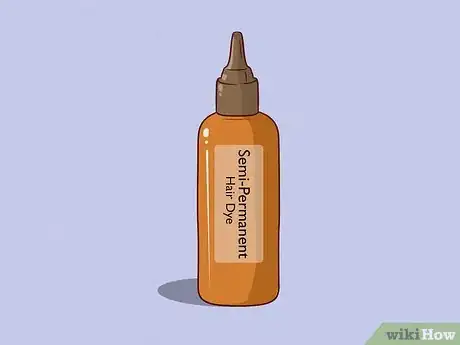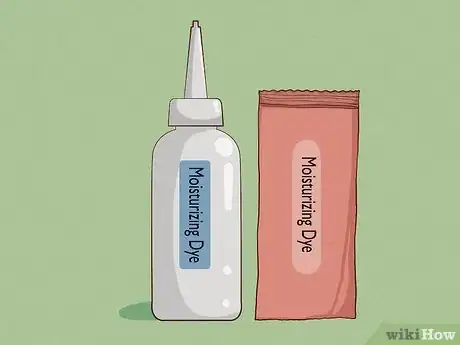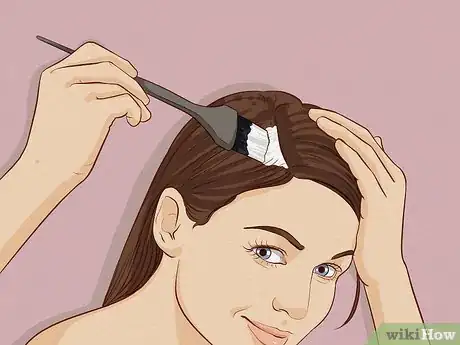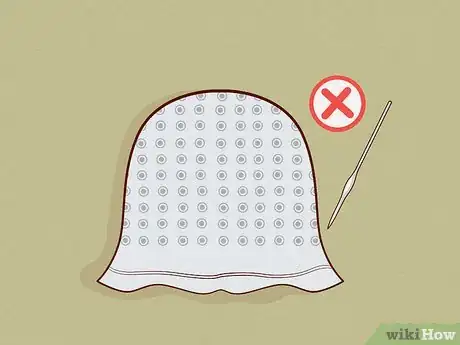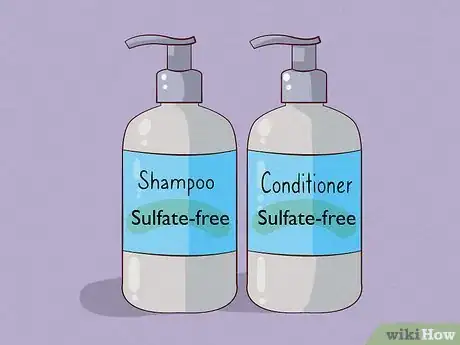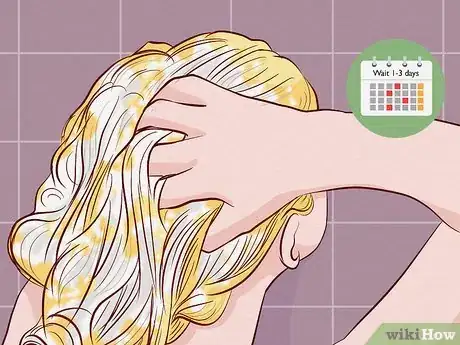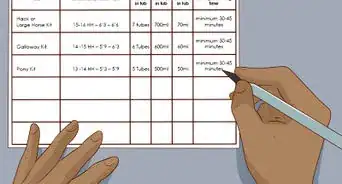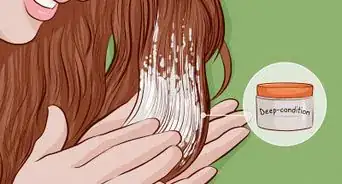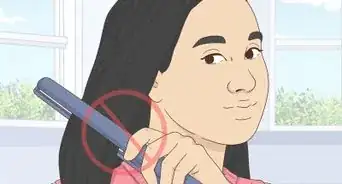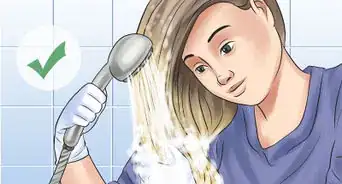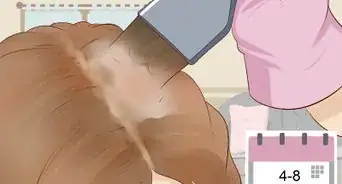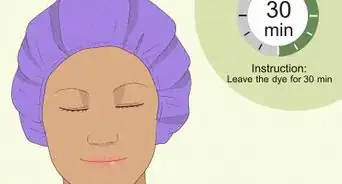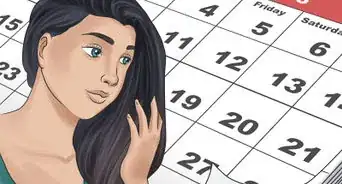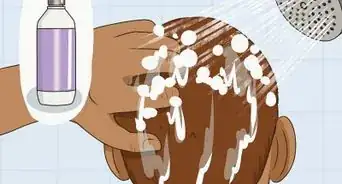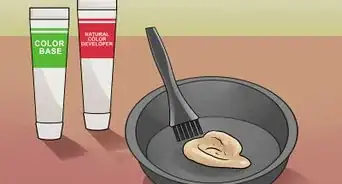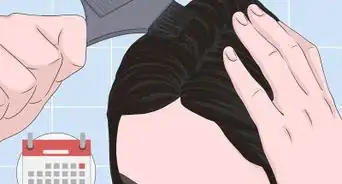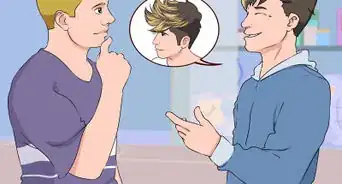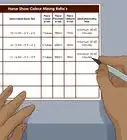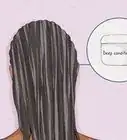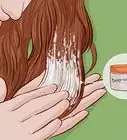This article was co-authored by Michael Van den Abbeel and by wikiHow staff writer, Janice Tieperman. Michael Van den Abbeel is a Professional Hair Stylist and the Owner of Mosaic Hair Studio and Blowout Bar in Orlando, Florida. He has been cutting, styling, and coloring hair for over 17 years. Michael loves showing his clients how to wash and wear their hair easily and effortlessly. Mosaic Hair Studio and Blowout Bar is recognized as a Diamond Top Tier level Wella salon.
There are 11 references cited in this article, which can be found at the bottom of the page.
This article has been viewed 198,442 times.
Coloring your hair isn’t always a great idea, especially if it’s already damaged. Thankfully, there’s an easy way to tell if your hair can handle a dye job. Pull on a small section of your hair so it’s completely taut, then drip a drop of water on top. If it takes less than 10 seconds for the water to soak into the strands, your hair is too damaged and needs to be repaired before you can color it.[1] If your hair passes the test, give your locks a bit of TLC before applying any new color. With the right products and precautions, you can safely color your hair without putting it at risk.
Steps
Hair Care and Prep
-
1
-
2Trim away any split ends. Unfortunately, there’s no sure-fire way to permanently fix broken hair besides giving it a trim. Comb through your hair and pinch the bottom of the strands with your pointer and middle fingers. Grab a pair of clean, sharp scissors and snip away any damaged, broken hair.[5] Take a close look at all your hair to make sure you’ve snipped away any broken, damaged sections.[6]
- Unfortunately, natural hair tends to get damaged more often since it’s so bendy.
Advertisement -
3Double-condition your hair. Lather your damaged hair with a nourishing conditioner while you’re in the shower. Rinse out the extra product before stepping out of the shower. Afterwards, massage a leave-in conditioner into your hair while it’s still damp.[7]
- Once a week, you can switch out your traditional leave-in conditioner for a deep conditioner.
-
4Nourish your locks with a protein treatment. Protein treatments can help strengthen and replenish damaged hair. You can get one done at a salon, or try an at-home treatment. As a general rule of thumb, only do protein treatments every 1-2 weeks—otherwise, they could actually make your hair more brittle.[8]
- Make sure that you follow all of the instructions for using the protein mask. Leaving the product on for too long can cause your hair to become brittle.
-
5Use a conditioning hair mask the day before coloring your hair. Apply a deep conditioning mask the day before you plan on dyeing your hair. Then, leave it in for the recommended time frame before washing it out.[9] Look for a mask labeled as “hydrating,” which helps nourish your hair before you color it.[10]
Best Products and Practices
-
1Pick out a semi-permanent dye to prevent extra damage. Permanent hair dyes can do a lot of damage to your hair, and aren’t a great option if your hair is already damaged.[13] Instead, try a semi-permanent hair rinse that can change up your hair color without doing a lot of damage. Look for products that have some nourishing ingredients in the formula, like aloe vera, jojoba oil, or vitamin E.[14]
- Temporary dyes are the safest dye to use since they usually wash out after a day.[15]
-
2Color your hair with a moisturizing dye. Look for moisturizing dye products that are specifically designed to help repair damaged hair. It’s okay if the dye has ammonia—while this ingredient isn’t great, ammonia-free dyes can do even more damage to your hair, since they need to stay on longer.[16]
-
3Apply the dye just to your roots if you can. Avoid applying dye throughout your hair—since your hair is already damaged, you don’t want to expose it to a lot of extra chemicals. Instead, apply the dye over your natural roots, which protects your actual strands.[17]
-
4Stay away from highlighter cap kits. Highlighter cap kits are really convenient when you’re at home, but bleaching already-bleached hair damages it further. Instead, look for manual highlighting kits, where you brush on the product yourself.[18]
-
5Use shampoos and conditioners designed for colored hair. Look for products labeled as “sulfate-free,” so you don’t end up damaging your locks. Search for shampoos and conditioners that are listed as “color-safe” or “for color-treated hair”—these are gentler on your tresses.[19]
-
6Wait 1-3 days before washing your hair. Your dye will fade a lot faster if you wash it right after the fact. At a bare minimum, wait at least 24 hours before you give your hair a good wash.[20]
- As a general rule of thumb, don’t wash your hair everyday. The more you wash your hair, the faster your color will fade.
- Only shampoo a couple of times during the week after you’ve dyed your hair.[21]
Expert Q&A
Did you know you can get expert answers for this article?
Unlock expert answers by supporting wikiHow
-
QuestionHow can I protect my hair after it's dyed?
 Michael Van den AbbeelMichael Van den Abbeel is a Professional Hair Stylist and the Owner of Mosaic Hair Studio and Blowout Bar in Orlando, Florida. He has been cutting, styling, and coloring hair for over 17 years. Michael loves showing his clients how to wash and wear their hair easily and effortlessly. Mosaic Hair Studio and Blowout Bar is recognized as a Diamond Top Tier level Wella salon.
Michael Van den AbbeelMichael Van den Abbeel is a Professional Hair Stylist and the Owner of Mosaic Hair Studio and Blowout Bar in Orlando, Florida. He has been cutting, styling, and coloring hair for over 17 years. Michael loves showing his clients how to wash and wear their hair easily and effortlessly. Mosaic Hair Studio and Blowout Bar is recognized as a Diamond Top Tier level Wella salon.
Experienced Hair Colorist
-
QuestionCan you repair damaged hair?
 Laura MartinLaura Martin is a Licensed Cosmetologist in Georgia. She has been a hair stylist since 2007 and a cosmetology teacher since 2013.
Laura MartinLaura Martin is a Licensed Cosmetologist in Georgia. She has been a hair stylist since 2007 and a cosmetology teacher since 2013.
Licensed Cosmetologist
-
QuestionI don't have strong enough hair, and I want to dye my hair light pink. How could I strengthen my hair enough to get pink hair?
 Laura MartinLaura Martin is a Licensed Cosmetologist in Georgia. She has been a hair stylist since 2007 and a cosmetology teacher since 2013.
Laura MartinLaura Martin is a Licensed Cosmetologist in Georgia. She has been a hair stylist since 2007 and a cosmetology teacher since 2013.
Licensed Cosmetologist
Warnings
- Hair dye can cause an allergic reaction. Always do a patch test at least 24 hours before dyeing your hair, even if you have dyed it before.⧼thumbs_response⧽
- You should never get more than 1 major treatment when you’re at the salon, whether it’s hair dye, hair relaxing, or a perm.[22]⧼thumbs_response⧽
References
- ↑ https://www.marieclaire.co.uk/news/beauty-news/how-to-tell-if-your-hair-is-too-damaged-to-be-dyed-31389
- ↑ https://www.aad.org/public/diseases/hair-loss/insider/stop-damage
- ↑ https://www.goodhousekeeping.com/beauty/hair/tips/a15884/fix-damaged-hair/
- ↑ https://www.aad.org/public/diseases/hair-loss/insider/stop-damage
- ↑ https://m.youtube.com/watch?v=pA6FaBIa3iM&t=1m33s
- ↑ https://www.goodhousekeeping.com/beauty/hair/tips/a15884/fix-damaged-hair/
- ↑ https://www.goodhousekeeping.com/beauty/hair/tips/a15884/fix-damaged-hair/
- ↑ Michael Van den Abbeel. Professional Hair Stylist. Expert Interview. 7 January 2019.
- ↑ Michael Van den Abbeel. Professional Hair Stylist. Expert Interview. 7 January 2019.
- ↑ https://www.esalon.com/hair-color-mastery/colorist-tips/10-things-to-know-before-coloring-hair
- ↑ Michael Van den Abbeel. Professional Hair Stylist. Expert Interview. 7 January 2019.
- ↑ https://www.goodhousekeeping.com/beauty/hair/g29627145/diy-hair-masks/
- ↑ https://www.truthabouthaircolor.com/hair-dye-health/different-types-of-hair-dye
- ↑ https://www.readersdigest.co.uk/lifestyle/fashion-beauty/how-to-dye-your-hair-without-damaging-it
- ↑ https://www.truthabouthaircolor.com/hair-dye-health/different-types-of-hair-dye
- ↑ https://www.goodhousekeeping.com/beauty/hair/tips/a15884/fix-damaged-hair/
- ↑ https://www.goodhousekeeping.com/beauty/hair/tips/a15884/fix-damaged-hair/
- ↑ https://www.goodhousekeeping.com/beauty/hair/tips/a15884/fix-damaged-hair/
- ↑ https://www.insider.com/dyed-hair-mistakes-2018-11#you-didnt-wait-long-enough-between-coloring-and-shampooing-10
- ↑ https://www.insider.com/dyed-hair-mistakes-2018-11#you-arent-using-any-uv-protection-8
- ↑ Michael Van den Abbeel. Professional Hair Stylist. Expert Interview. 7 January 2019.
- ↑ https://www.aad.org/public/diseases/hair-loss/insider/stop-damage
About This Article
Before you color your damaged hair, get a trim to remove split ends, which will help strengthen your hair. You should also condition your hair more often to ensure it’s well hydrated, since coloring hair can cause it to dry out. When it comes to choosing your hair dye, go for one that’s free from ammonia and contains oil jelly or other moisturizers, which will make it less harmful. Try to use as little product as possible, since large quantities of dye are more like to cause further harm. Remember to avoid lightening your hair if it’s damaged, since creating a lighter color requires a lot of damage to the cuticle. For tips on how to care for your hair after dying, including with color protection shampoo and conditioners, read on!


